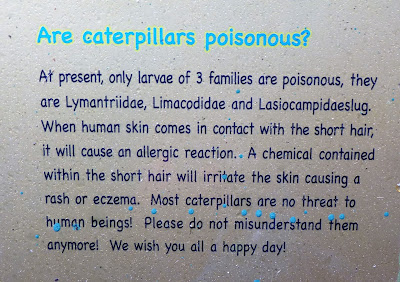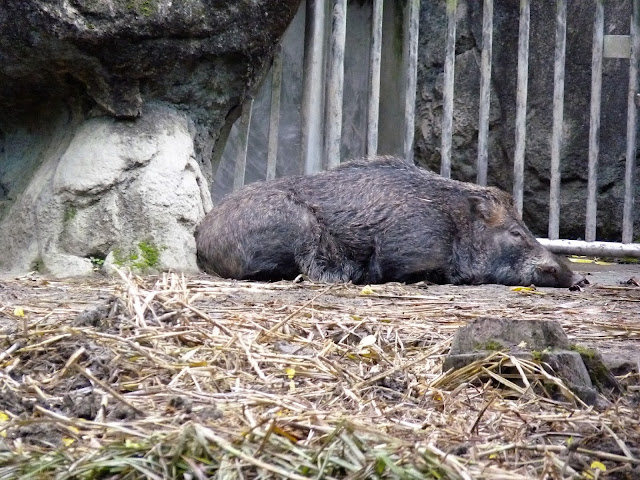We were supposed to go somewhere else, but because of the strong winds and rain we ended up in the zoo. To my surprise we explored a part of the zoo that I have never been to before. We went to the Insect Valley. Kids kept asking if it's really a zoo, as there were no (big) animals, only insects.
Of course all the kids wanted to know which caterpillars are safe to touch and which we should avoid getting in contact with.
W spotted not only caterpillars, but adult insects too, although not many as they must have been hiding from the rain:
The plant on the photo below produces some sweet sap that attracts ants. The sap stays only in spot that the stem comes out. The plant counts on ants to scare other insects that would otherwise eat the leaves. Smart, isn't it?
This is not a snail trail as many think. It's a tiny larvae moving inside the leaf and feeding off it.
So we walked on the path where we were able to spot many caterpillars:
 |
| Cocoa tussock moth caterpillar - 小白紋毒蛾幼蟲 - Orgyia postica |
 |
| 巨網燈蛾幼蟲 - Macrobrochis gigas |
 |
| 暗點燈蛾 - Lemyra imparilis |
 |
| Not a very good photo, sorry. Geometer moth caterpillar - 尺蛾幼蟲 - Geometridae - Gąsienica motyla nocnego z rodziny miernikowcowatych |
 |
| ? |
Of course all the kids wanted to know which caterpillars are safe to touch and which we should avoid getting in contact with.
W spotted not only caterpillars, but adult insects too, although not many as they must have been hiding from the rain:
The plant on the photo below produces some sweet sap that attracts ants. The sap stays only in spot that the stem comes out. The plant counts on ants to scare other insects that would otherwise eat the leaves. Smart, isn't it?
This is not a snail trail as many think. It's a tiny larvae moving inside the leaf and feeding off it.
Huge insects were everywhere:
We also looked at some trees and shrubs and even tried a few wild fruits:
 |
| Oldham's Saurauia - 水冬瓜 - Saurauia oldhamii It's berries are really yummy! |
 |
| These blue berries also taste nice. Round-leaved lasianthus - 圓葉雞屎 - Lasianthus wallichii |
Do you know why the branches of this tree fern do not fall off when they dry? By bending down instead of dropping off the dead branches help to protect the tree fern from vines wanting to climb it and live off it.
On our way back to the exit we strolled through the area of the zoo where animals living in the wild in Taiwan are kept. We met some macaques grooming and eating.


















Comments
Post a Comment